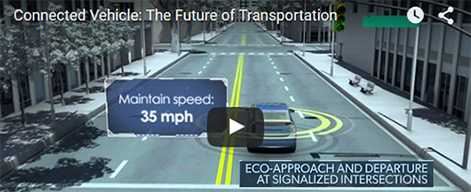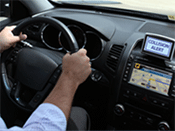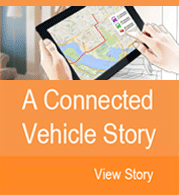Resources
The U.S. Department of Transportation's (USDOT’s) Connected Vehicle program is working with state and local transportation agencies, vehicle and device makers, and the public to test and evaluate technology that will enable cars, buses, trucks, trains, roads and other infrastructure, and our smartphones and other devices to “talk” to one another. Cars on the highway, for example, would use short-range radio signals to communicate with each other so every vehicle on the road would be aware of where other nearby vehicles are. Drivers would receive notifications and alerts of dangerous situations, such as someone about to run a red light as they’re nearing an intersection or an oncoming car, out of sight beyond a curve, swerving into their lane to avoid an object on the road.
Read More
Connected vehicles could dramatically reduce the number of fatalities and serious injuries caused by accidents on our roads and highways. While the number of people surviving crashes has increased significantly thanks to airbags, anti-lock brakes, and other technology, the USDOT is shifting its focus from helping people survive crashes to preventing crashes from happening in the first place.
Every year, there are over 5 million crashes on our roads. Of these crashes, over 30,000 people still die, and many more sustain serious injuries, according to the National Highway Traffic Safety Administration (NHTSA). In fact, the leading cause of death among young children and young adults is vehicle crashes, according to the Centers for Disease Control.

Connected vehicle technology will enable cars, trucks, buses, and other vehicles to "talk" to each other with in-vehicle or aftermarket devices
that continuously share important safety and mobility information. More.
Another NHTSA study of connected vehicle technologies has shown that they have the potential to reduce up to 80 percent of crashes where drivers are not impaired, which would save a significant number of lives and prevent millions of crash-related injuries every year.
Connected vehicles have significant advantages over new technologies now appearing in high-end vehicles, such as radar, lidar, cameras, and other sensors. For one thing, connected vehicle technologies and applications have a greater range than on-board vehicle equipment, which will allow you to receive alerts of hazardous situations much earlier, providing more time to react and prevent an accident. Also, connected vehicle technology doesn't depend on “line of sight” communications to be effective, unlike radar. So if a car ahead of you is braking hard on the other side of a hill due to an obstruction, you would receive notification even though you can't see and aren't aware of the dangerous situation developing. Connected vehicle technology is also less expensive to install than radar and camera equipment in vehicles. This will enable it to become standard equipment in the future on practically all vehicles, not just luxury cars.
In addition to the tremendous safety potential of connected vehicles, they also promise to increase transportation options and reduce travel times. Traffic managers will be able to control the flow of traffic more easily with the advanced communications data available and prevent or lessen developing congestion. This could have a significant impact on the environment by helping to cut fuel consumption and reduce emissions.

















